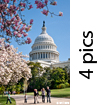
1 Washington in Bloom
The first day of my voyage, 31 March, turned out to be arduous. After getting raised by the alarm at 5.45 AM, rushing to Arlanda Airport, flitting to Copenhagen and then reading through eight looong hours of flight to Dulles Airport in Washington DC, a long one hour's queue had to be endured at the border control. Finally just a 50 minutes´ cab ride to Churchill hotel. By then it was 5 PM local time, albeit already 2 AM in the morning by my body clock.
I was prepared to make it an early night had the hotel clerk not informed me that this was the day of cherry blossoms, so there was no rest for this poor traveller. Just a quick jump into the next cab to get off to the promised fields of cherry trees, thank you!
Unfortunately, everyone else in town seemed to have the same idea, so the cab did not move forward at any appreciable speed. I finally stopped it and continued the long journey to the Washington Monument on foot. The sun was moving rashly towards the horizon, so speed was in order. Still, I managed to observe and catch some nice scenery before the sun set and I promised myself to be back there the morning after.
This promise I indeed kept, getting up with the sun and even having breakfast at the hotel, an unheard of action at 16 dollars! This time the cab driver got me to the Lincoln Memorial in reasonable time. From there I walked the length of the whole national park, which lies between the Lincoln Memorial and Congress, taking in the beautiful scenery and even catching it with the camera now and then. Cherry blossoms dominated the scenery, particularly around the Tidal Basin, with the Jefferson Memorial providing an enticing background. Understandably, I was not the only one benefiting from the scenery; however, I was early enough not to be trampled upon by enthusiastic fellow wanderers.
Although weary after the long walk to Capitol Hill, a mound crowned by the impressive Congress building that is almost as big as the "Palais de Justice" in Brussels, I mustered last vestiges of energy in visiting the edifice. Among hundreds and hundreds of fellow tourists, mostly Americans, the guides shepherded me with commendable efficiency around the premises. We were allowed to visit the huge expanse under the cupola, as well as the former Hall of Representatives. I was pleasantly surprised by the building as well as by the guiding organisation, in particular when comparing them with their counterparts in Brussels.
Having said this, the whole inner city of Washington DC exhibits an air of subtle elegance that is, to my regret, completely missing in the capital of Europe. It could be that it takes hundreds of years of painful piling, stone upon stone, to get the desired effect, rather than piling concrete like elephant droppings on suffering neighbourhoods, as is being done in Brussels.
As a comparison, the Congress building was finished first in 1886, 90 years after construction began. The European Parliament was rushed through (with only scant planning) within 15 years. Not to mention the Commission building that is still showing its disgrace, despite 15 years of refurbishing. Fortunately, none of the European buildings are set in stone, as the Washington buildings are, so they could be replaced without further ado, if Europe would get its act together.
After my exhausting exercises at the cherry blossom compound, I met, in the evening, with an old friend of mine, Lorenzo Brown. We were graduate students together in Stockholm in the late seventies, so it was only fitting to have him join my "voyage down memory lane" for a short while. It turned out to be very educating. Lorenzo, although having started his graduate studies after me, managed to finish them a full eight years before me. It may have helped that he left the university of Stockholm to finish his thesis back home, since thesis productivity in Stockholm in those days was at an all time low.
Post a short spell as professor at Howard, Lorenzo became senior economist at the Federal Energy Agency, helping to refurbish that body's regulatory regime. But soon thereafter he had to answer his wife's urgent calls to help him build up a publishing emporium, based on the intriguing magazine "Sister to Sister".
He told me about his recent professional experiences during the "great recession". It turned out that this turbulence had a disturbing effect on morale in the US world of small business. For a short time it was like relations with suppliers and distributors were breaking down for his magazine business, with everyone desperately trying to save his own financial skin, in view of disappearing consumer demand. His company was thus strongly affected by the general turmoil, but he managed to steer it through the "maelstrom", and he now has good hopes for its future, since the necessary adaptation resulted in a leaner and more efficient enterprise.
All in all, I was glad to having organised the trip to California with this in-between recess. Not only did it help me overcome the travails of jetlag but, above all, it provided me with some unforeseen and welcome experiences.



